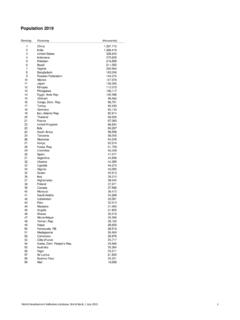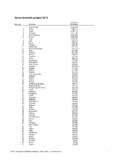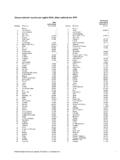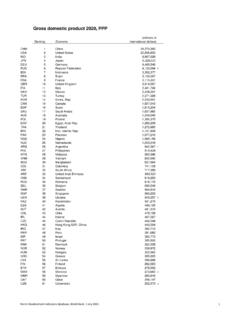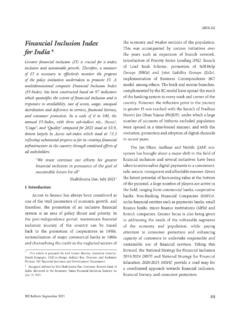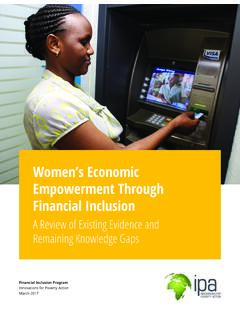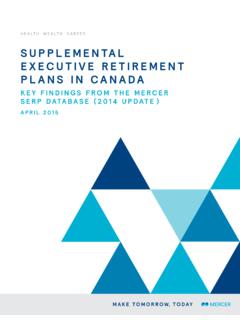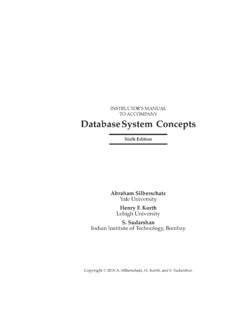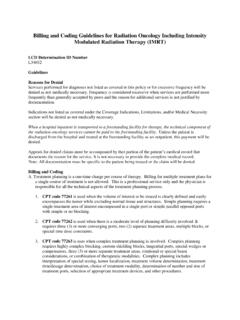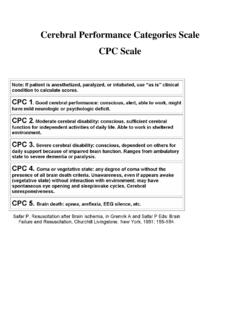Transcription of G20 FINANCIAL INCLUSION INDICATORS Overview
1 1 G20 FINANCIAL INCLUSION INDICATORS Overview The Group of Twenty (G20) recognizes that FINANCIAL INCLUSION is a key enabler in the fight against poverty. The pursuit of inclusive development is leading to a greater focus on FINANCIAL INCLUSION policies and initiatives. Reliable data covering the major components of sustainable FINANCIAL INCLUSION development is critical to inform these policies and to monitor the effect of initiatives. Data also provides a starting point on which to base ambitious FINANCIAL INCLUSION targets. At the Cannes Summit in 2011, G20 leaders agreed to the recommendation by the Global Partnership for FINANCIAL INCLUSION (GPFI) to support global and national FINANCIAL INCLUSION data efforts. Subsequently, G20 leaders endorsed the G20 Basic Set of FINANCIAL INCLUSION INDICATORS at Los Cabos Summit in 2012, born out of the work of the GPFI.
2 As committed at the time of the endorsement of the Basic Set of FINANCIAL INCLUSION INDICATORS , and in support of the key focus area of FINANCIAL literacy under the Russian G20 Presidency, the GPFI developed a more comprehensive set of FINANCIAL INCLUSION INDICATORS . Their aim was to deepen the understanding of the FINANCIAL INCLUSION landscape. This expanded set including INDICATORS on FINANCIAL literacy and the quality of FINANCIAL service provisioning and consumption was endorsed at the G20 St. Petersburg Summit in 2013. Under the leadership of the Chinese G20 Presidency in 2016, and in consultation with G20 members and GPFI implementing partners, new INDICATORS were introduced to measure the use, availability, and quality of digital FINANCIAL services. The expansion and revision of the existing set of INDICATORS is driven by the development of new digital models, as well as the availability of new data on both the demand for and supply of digital FINANCIAL services.
3 As part of the current Japanese G20 Presidency, new INDICATORS on savings for old age have been introduced along with an update of several current INDICATORS to include disaggregation by various age categories. Newly included INDICATORS , collected in partnership with Gallup, also cover access to mobile phone and the internet around the world. Another new addition, collected in partnership with the Identification for Development (ID4D) initiative, measures ownership of national identification. INDICATORS cover a wide range of payment instruments and access channels. The underlying account used for payments may be held with a bank or other FINANCIAL institution or an e-money account. Payments include those made on the internet, through a mobile phone or device connected to a Wi-Fi network, or using a point of sale (POS) terminal.
4 These INDICATORS can be collected by government statistical agencies and used to measure achievements and disparities in the use of digital FINANCIAL services and the technology and enabling environment needed to benefit from them. Used in conjunction with additional country-specific INDICATORS , the G20 FINANCIAL INCLUSION INDICATORS can inform policy-makers and enable monitoring of FINANCIAL INCLUSION development, both at a national and at a global level. 2 INDICATORS FINANCIAL INCLUSION is measured in three dimensions: (i) access to FINANCIAL services (ii) usage of FINANCIAL services (iii) quality of the products and the service delivery Both supply-side and demand-side data is included to form a comprehensive view. Countries are encouraged to collect their own data and supplement the INDICATORS (table below) with data on areas of specific relevance to the country context.
5 The data sources listed in the table below provide a useful starting point with which to populate the key INDICATORS . The availability, sustainability and robustness of data were the key criteria, with appropriateness and comprehensiveness, in selecting the G20 FINANCIAL INCLUSION INDICATORS . The data sources include the World Bank Global Findex database, IMF FINANCIAL Access Survey, Gallup World Poll, World Bank Enterprise Surveys, OECD National FINANCIAL Literacy and FINANCIAL INCLUSION Surveys, OECD Financing SMEs and Entrepreneurs Scoreboard, World Bank Doing Business, World Bank Global Survey on Consumer Protection and FINANCIAL Literacy, World Bank FINANCIAL Capability Surveys, and World Bank Global Payments Systems Survey. A glossary of indicator definitions is available at the GPFI data portal ( ). Although the scope of the G20 FINANCIAL INCLUSION INDICATORS is comprehensive enough to provide a holistic assessment, new data collection efforts, as well as evolving technology and business models, may well require additional or adapted INDICATORS in the future.
6 3 Summary Table: The G20 FINANCIAL INCLUSION INDICATORS Category Indicator Source Frequency USAGE INDICATORS : ADULTS 1AD Adults with an account Account (% age 15+) Percentage of adults who report having an account (by themselves or together with someone else) with a formal FINANCIAL institution or a mobile money provider WB Global Findex Triennial Active account (% age 15+) Percentage of adults who report making at least one deposit or withdrawal from their account in the past 12 months WB Global Findex Triennial 1B Number of accounts Deposit accounts per 1,000 adults Number of deposit accounts per 1,000 adults IMF FINANCIAL Access Surveys Annual 1C E-money accounts per 1,000 adults Number of e-money accounts per 1,000 adults WB Global Payments Systems Survey Annual 1D Mobile money transactions per 100,000 adults Number of mobile money transactions per 100,000 adults IMF FINANCIAL Access Surveys Annual 2AD Adults with credit at regulated institutions Borrowed from a FINANCIAL institution or used a credit card in the past year (% age 15+).
7 Percentage of adults with at least one loan outstanding from a bank or other formal FINANCIAL institution or used a credit card in the past year WB Global Findex Triennial 2B Outstanding loans per 1,000 adults Number of outstanding loans per 1,000 adults IMF FINANCIAL Access Surveys Annual 3 Adults with insurance Insurance policy holders per 1,000 adults Disaggregated by life and non-life insurance IMF FINANCIAL Access Surveys Annual 4 Cashless transactions Retail cashless transactions per 1,000 adults Includes: number of cheques, credit transfers, direct debits, payment card transactions (debit cards, credit cards), and payments by e-money instruments (card-based e-money instruments, mobile money products, and online money products) WB Global Payments Systems Survey Annual 5D Adults using digital payments Made or received digital payments (% age 15+) Percentage of adults using a transaction account (with a bank or other formal FINANCIAL institution or mobile money provider) to make or receive a digital FINANCIAL payment Includes: Use the internet to pay bills or make purchases online; Use a phone to pay bills, make purchases, or send or receive money from an account (with a bank or other formal FINANCIAL institution or mobile money provider); Use a debit or credit card to make a direct payment from an account.
8 Send or receive remittances to/from an account; Receive wages, government transfer payments, or agricultural payments to an account; Send utility or school fees from an account WB Global Findex Triennial 6A*,D Payment using a mobile phone or the internet (from an account) <Sub-indicator> Made payment using a mobile phone or the internet (% age 15+) Percentage of adults using a mobile phone or the internet to make or receive payments, to make a purchase, or to send or receive money through their FINANCIAL institution account or through the use of a mobile money service WB Global Findex Triennial 6B*,D Payment using a mobile phone <Sub-indicator> Used a mobile phone or the internet to check account balance in the past year (% age 15+) Percentage of WB Global Findex Triennial 4 adults using a mobile phone or the internet to check their balance for a FINANCIAL institution account in the past 12 months.
9 6C* Payment using a bank card <Sub-indicator> Made payment using a debit or a credit card card (% age 15+) Percentage of adults using a debit or credit card to directly make a payment from an account WB Global Findex Triennial 6D*,D Payment using account <Sub-indicator> Received wages or government transfers into an account (% age 15+) Percentage of adults who receive wages or government transfers into an account (with a bank or other formal FINANCIAL institution or mobile money provider) WB Global Findex Triennial 6ED Saving propensity Saved at a FINANCIAL institution (% age 15+) Percentage of adults that saved at a bank or other formal FINANCIAL institution in the past year WB Global Findex Triennial Saved for old age (% age 15+) Percentage of adults that saved for old age in the past year WB Global Findex Triennial USAGE INDICATORS .
10 ENTERPRISES 7AG Formally banked enterprises SMEs with an account at a formal FINANCIAL institution (%) Percentage of Small or Medium Sized Enterprises (SMEs) with an account at a bank or other formal FINANCIAL institution WB Enterprise Surveys 3-5 years** 7B SME deposit accounts (as a % of non- FINANCIAL corporation borrowers) Number of SME deposit accounts (as a % of non- FINANCIAL corporation borrowers) IMF FINANCIAL Access Surveys Annual 9AG Enterprises with outstanding loan or line of credit at regulated institutions SMEs with an outstanding loan or line of credit (%) Percentage of SME with outstanding loan or line of credit from a bank or other formal FINANCIAL institution WB Enterprise Surveys 3-5 years** 9B SME loan accounts (as a % of non- FINANCIAL corporation borrowers) Number of SME loan accounts (as a % of non- FINANCIAL corporation borrowers) IMF FINANCIAL Access Surveys Annual 10G Digital payments to or from enterprises SMEs that send or receive digital payments from an account (%) Percentage of SMEs that send or receive digital payments from an account WB Enterprise Surveys (Aspirational) 3-5 years** ACCESS INDICATORS : PHYSICAL POINTS OF SERVICE 11A Points of service Branches per 100,000 adults Number of branches per 100,000 adults IMF FINANCIAL Access Surveys Annual 11B ATMs per 100,000 adults Number of ATMs per 100,000 adults IMF FINANCIAL Access Surveys Annual 11C Agents of payment service providers per 100,000 adults Includes.

